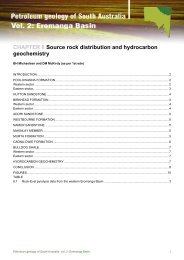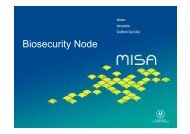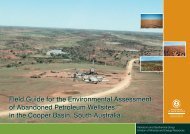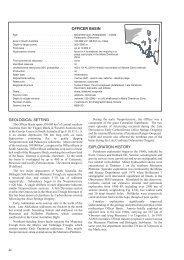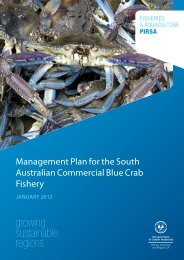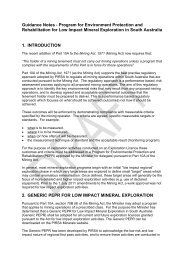Chapter 2: History of petroleum exploration and development - PIRSA
Chapter 2: History of petroleum exploration and development - PIRSA
Chapter 2: History of petroleum exploration and development - PIRSA
Create successful ePaper yourself
Turn your PDF publications into a flip-book with our unique Google optimized e-Paper software.
Petroleum geology <strong>of</strong> South Australia. Vol. 4: Cooper Basin.first well, Munkarie 1 discovered what ultimately turned outto be 2832 x 10 6 m 3 (100 bcf) <strong>of</strong> gas. SAPEG then tried newconcepts in drilling Coochilara <strong>and</strong> Kirby. The latter was adeep well into tight reservoirs hoping to find permeablestreaks. Both were plugged <strong>and</strong> ab<strong>and</strong>oned, Kirby 1 aftersub-commercial gas flows.SAPEG’s future was uncertain: it was initially expectedto operate for one year when the concept would be reviewed.Yet again, changing circumstances opened a window <strong>of</strong>opportunity. The Federal Liberal Government under M.Fraser had determined to sell its holding in the Cooper Basinwhich the PMA had acquired from Delhi under Connor’s‘buy back the farm’ policy. The State Minister <strong>of</strong> Mines <strong>and</strong>Energy (1975–79), H.R. Hudson, indicated to the FederalMinister <strong>of</strong> National Resources that he would prefer to seethe PMA’s interest sold to South Australia. On a trip to theUnited Kingdom <strong>and</strong> Europe in 1976 Hudson hadinvestigated government instrumentalities, particularly theirenergy policies. Based on his observations overseas,Hudson initiated the idea <strong>of</strong> creating a company to acquirethe holding, which was possible because its location withinPELs 5 <strong>and</strong> 6 required the Minister’s assent to any transfer.A limited liability company, the South Australian Oil <strong>and</strong>Gas Corporation (SAOG), was incorporated in September1977 after SAPEG was hived <strong>of</strong>f from the re-namedDepartment <strong>of</strong> Mines <strong>and</strong> Energy.SAPEG’s arrangements with the Producers for exploringin PELs 5 <strong>and</strong> 6 were transferred to SAOG which then joinedthe Producers Unit. The State Government was now asignificant shareholder in the hydrocarbon reserves <strong>of</strong> theCooper Basin. SAOG was a government instrumentality setup to look after the interests <strong>of</strong> the people <strong>of</strong> South Australia,yet it was expected to operate as a commercial entity. Therewas a view that the entity would only last a few years,probably until a decision about future reserves had beenmade. Few anticipated that the company would grow into anindependent explorer/producer in its own right <strong>and</strong> theGovernment was ambivalent about the matter. SAOGeventually outgrew its function as an arm <strong>of</strong> governmentcontrolling <strong>development</strong> in the Cooper Basin <strong>and</strong> itgradually adopted a more commercial orientation. But therewas little immediate monetary gain for the Governmentbecause SAOG sought to establish its credibility as anexplorer, <strong>and</strong> as a member <strong>of</strong> the Producers Unit, byre-investing in <strong>exploration</strong> <strong>and</strong> its own future growth.Successive State Governments accepted this, although from1980 steps towards privatising SAOG were taken.COOPER BASIN LIQUIDS PROJECTIn the 1980s two milestones occurred in SouthAustralia’s <strong>petroleum</strong> resources sector. The first was thedemise <strong>of</strong> Delhi on the local scene. In January 1979 Santosacquired the sole responsibility for the <strong>development</strong> <strong>and</strong>production <strong>of</strong> the Cooper Basin gas <strong>and</strong> condensate fields.Meanwhile, Delhi became the <strong>exploration</strong> operator in PELs5 <strong>and</strong> 6 <strong>and</strong> held the <strong>development</strong> <strong>and</strong> production role for theEromanga oil fields. During 1981 CSR purchased Delhi’sAustralian <strong>petroleum</strong> interests which, in turn, were acquiredby Esso Exploration <strong>and</strong> Production Australia Inc. The newowner attempted to maintain operatorship <strong>of</strong> the <strong>exploration</strong>operations but Santos <strong>and</strong> its subsidiary companies Vamgas<strong>and</strong> Alliance Oil (with the help <strong>of</strong> SAOG) voted againstFractionation plant at night, Port Bonython, July 1984.43378)(PhotoEsso. Santos became the operator for all <strong>exploration</strong> <strong>and</strong><strong>development</strong> in PELs 5 <strong>and</strong> 6. The Delhi <strong>of</strong>fice in Adelaideclosed in January 1988. The second notable event followedfrom the Cooper Basin being proved to contain Australia’slargest known onshore oil reserves. This ultimatelyfacilitated the $1.5 billion Cooper Basin Liquids Projectwhich saw an expansion <strong>of</strong> facilities in the region.The oil discoveries made during the late 1970s, togetherwith the large amounts <strong>of</strong> condensate which could beextracted from the supply <strong>of</strong> dry gas to Sydney <strong>and</strong>Adelaide, made a project to develop <strong>and</strong> market CooperBasin gas liquids <strong>and</strong> oil feasible. This took the place <strong>of</strong> thepreviously proposed petrochemical plant. In early 1980Santos (on behalf <strong>of</strong> the Producers) announced the decisionto proceed with a liquids project. In 1981 the StateGovernment passed the Stony Point (Liquids Project)Ratification Act to assist the project, involving the granting<strong>of</strong> a special pipeline licence for the 659 km Moomba – PortBonython liquids pipeline <strong>and</strong> exemption from varioustaxes. The first stage <strong>of</strong> the project, the construction <strong>of</strong> afractionation plant to split the <strong>petroleum</strong> into ethane,propane, butane, naphtha (condensate) <strong>and</strong> crude oil atStony Point on Spencer Gulf (now Port Bonython), began in1981. In February 1983 the first shipment <strong>of</strong> condensatereceived through the Moomba – Port Bonython pipeline wasshipped to the Geelong oil refinery in Victoria; in March1983 the first shipment <strong>of</strong> Cooper Basin crude oil was sentfrom Port Bonython; <strong>and</strong> in June 1984 LPG productionbegan, with the first loading for export to Japan coinciding29










